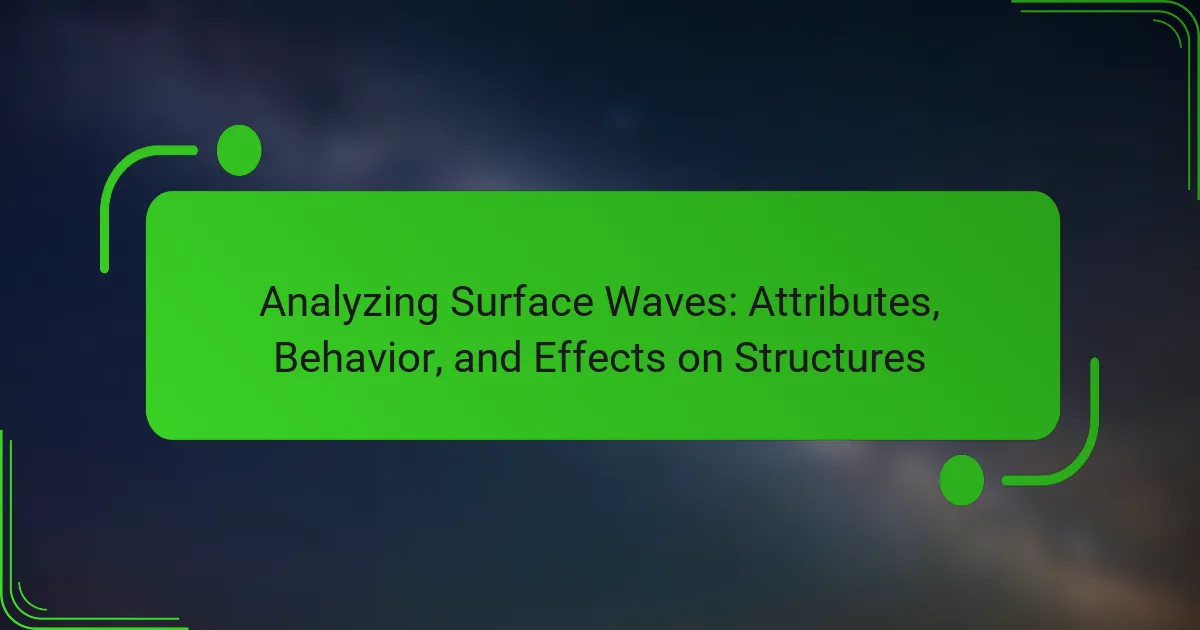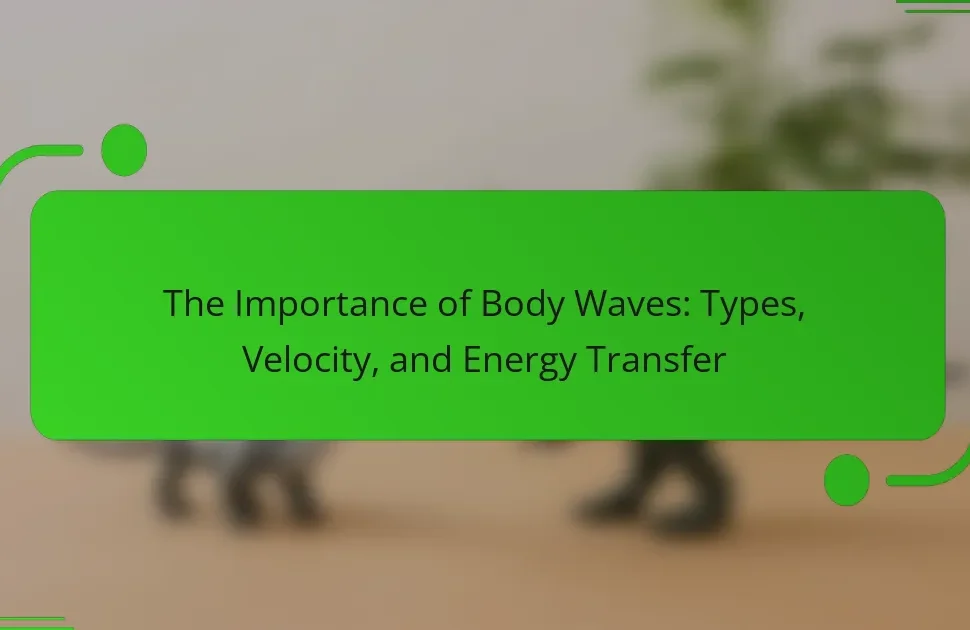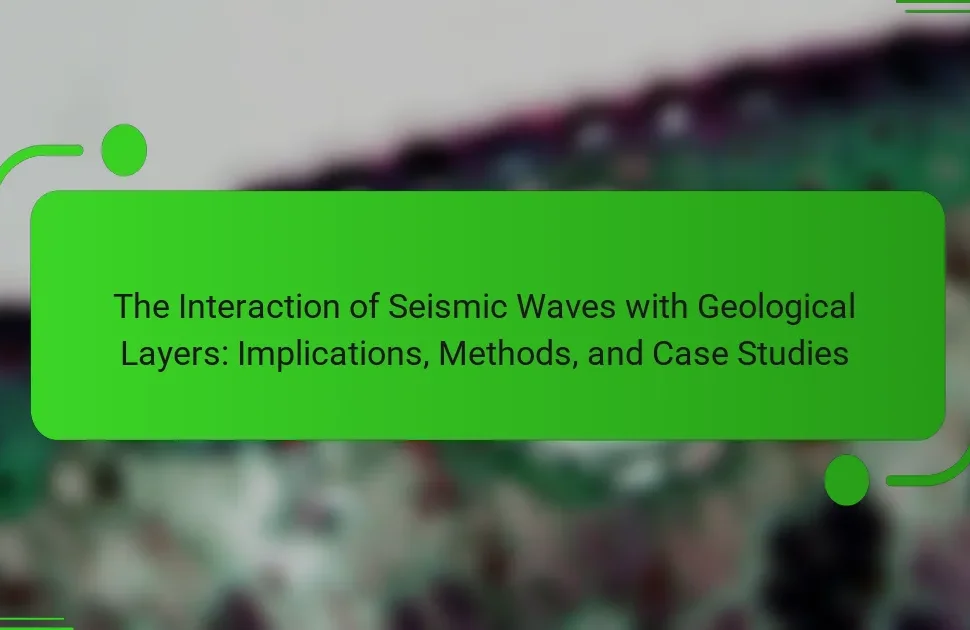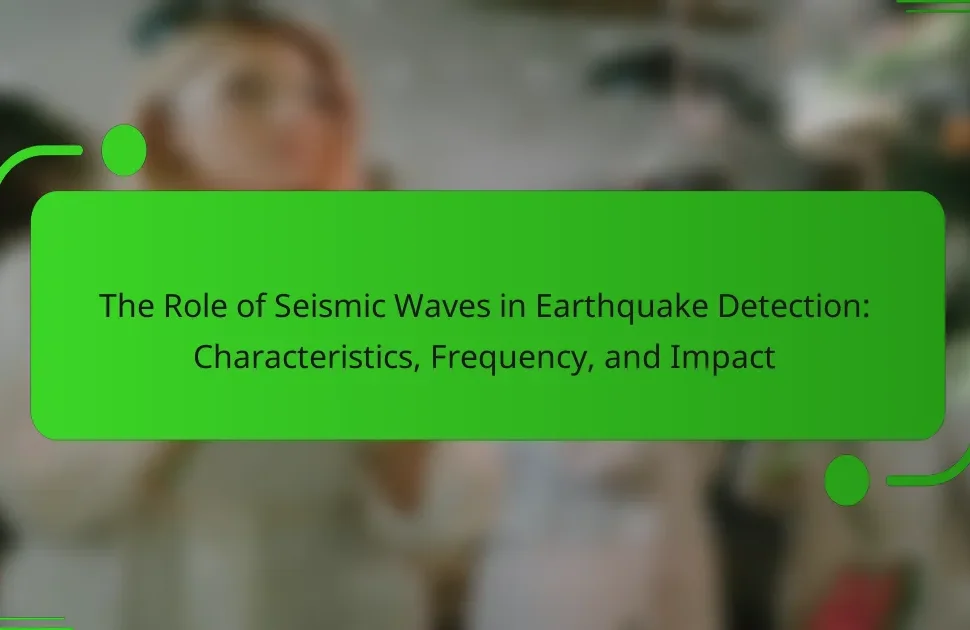Surface waves are seismic waves that travel along the Earth’s surface, primarily generated by earthquakes, and are responsible for significant ground shaking. They are categorized into two main types: Love waves, which create horizontal motion, and Rayleigh waves, which produce elliptical movement resulting in both vertical and horizontal ground displacement. Surface waves typically have longer wavelengths than body waves, allowing them to travel greater distances and often inflict more damage on structures. Their behavior varies across different environments due to factors such as medium properties and boundary conditions, impacting their speed, amplitude, and potential for structural damage during seismic events. Historical earthquake data indicates that surface waves are a major contributor to ground motion and structural vulnerability, especially near the earthquake epicenter.
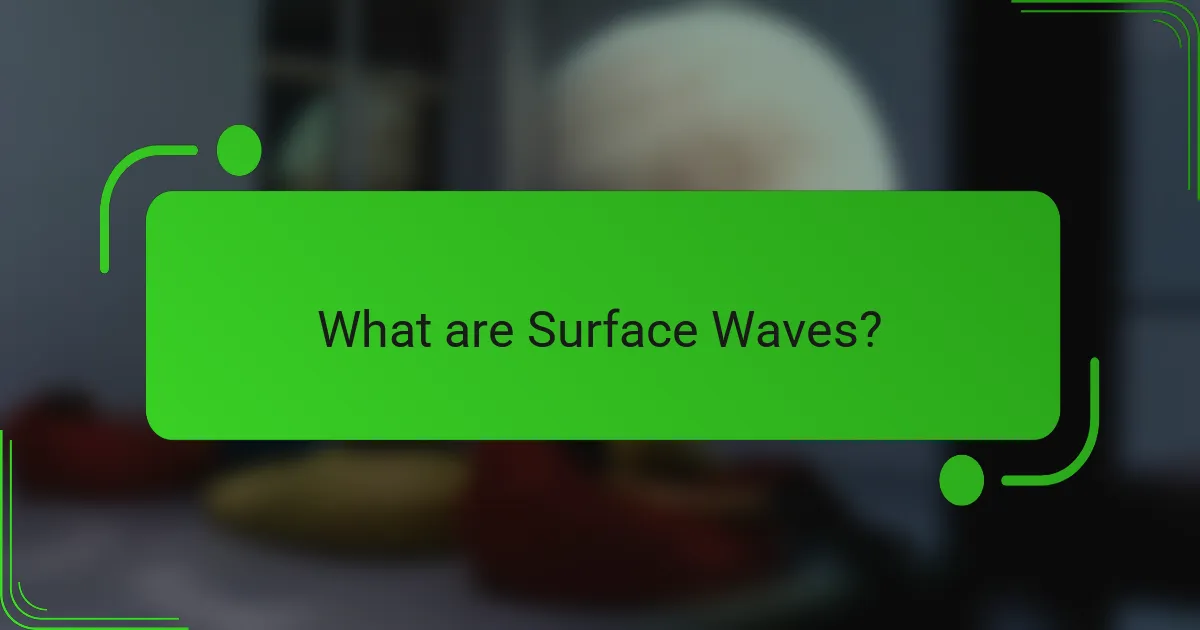
What are Surface Waves?
Surface waves are a type of seismic wave that travel along the Earth’s surface. They are generated by earthquakes and can cause significant ground shaking. Surface waves consist mainly of two types: Love waves and Rayleigh waves. Love waves move horizontally, causing side-to-side motion. Rayleigh waves produce an elliptical motion, causing both vertical and horizontal ground movement. These waves typically have longer wavelengths than body waves. As a result, they can travel greater distances and often cause more damage. Studies show that surface waves account for most of the shaking felt during an earthquake. Their impact on structures can be severe, leading to increased stress and potential failure.
How do Surface Waves differ from other types of waves?
Surface waves differ from other types of waves by traveling along the interface between two media. They exhibit unique behaviors such as particle motion that is elliptical or circular, unlike longitudinal or transverse waves. Surface waves typically have larger amplitudes and decay more slowly with distance compared to body waves. This results in a more significant impact on structures during events like earthquakes. Research indicates that surface waves can cause extensive damage due to their prolonged duration and energy concentration at the surface level. For example, Rayleigh waves, a type of surface wave, are known for their destructive potential in seismic events.
What are the key characteristics of Surface Waves?
Surface waves are a type of wave that travel along the surface of a medium. They exhibit unique characteristics compared to other wave types. Surface waves have a particle motion that is elliptical or circular. This motion occurs in a vertical plane, leading to a decrease in amplitude with depth. The speed of surface waves is generally slower than that of body waves. They can cause significant damage during seismic events. Their energy can extend to large distances, affecting structures above ground. Surface waves are primarily responsible for the shaking felt during earthquakes.
Why are Surface Waves important in geophysics?
Surface waves are important in geophysics because they provide valuable information about the Earth’s subsurface. These waves travel along the surface and are sensitive to variations in material properties. They can reveal details about geological structures, such as faults and layers. Surface waves are also crucial for seismic hazard assessment. They often carry the most energy during an earthquake, affecting structures significantly. Their analysis aids in understanding wave propagation and predicting ground motion. Studies show that surface waves can be used for site characterization and resource exploration. Thus, their significance in geophysics is both practical and theoretical.
What are the primary attributes of Surface Waves?
Surface waves are characterized by their distinct propagation and behavior. They travel along the surface of a medium, such as water or the Earth’s crust. Surface waves exhibit a unique elliptical motion, where particles move in circular or elliptical paths. This motion diminishes with depth, leading to a significant amplitude at the surface.
In seismic contexts, surface waves are slower than body waves. They typically cause more damage due to their prolonged duration and larger amplitude. Surface waves can be classified into Love waves and Rayleigh waves, each with specific motion characteristics. Love waves move horizontally, while Rayleigh waves create an elliptical motion, similar to ocean waves.
These attributes make surface waves critical in engineering and geological studies. Their impact on structures can be profound, particularly during earthquakes. Understanding these attributes aids in designing resilient structures against seismic activity.
How does frequency affect Surface Wave behavior?
Frequency directly influences surface wave behavior. Higher frequencies lead to shorter wavelengths. This results in waves that can penetrate less deeply into materials. Conversely, lower frequencies produce longer wavelengths, allowing waves to travel further into the medium. The dispersion of surface waves is also frequency-dependent. Higher frequency waves tend to disperse more rapidly than lower frequency waves. This behavior affects how surface waves interact with structures. Research indicates that frequency variations can significantly alter wave amplitude and energy distribution. Understanding this relationship is crucial for engineering applications involving surface waves.
What role does amplitude play in Surface Waves?
Amplitude is a critical factor in surface waves, influencing their energy and impact. Higher amplitude indicates greater energy transfer, resulting in more pronounced wave effects. This energy affects how surface waves interact with structures. For example, larger amplitude waves can cause more significant erosion and damage to coastal infrastructure. Studies show that wave height and amplitude correlate with destructive potential during storms. Thus, understanding amplitude is essential for predicting surface wave behavior and mitigating risks to structures.
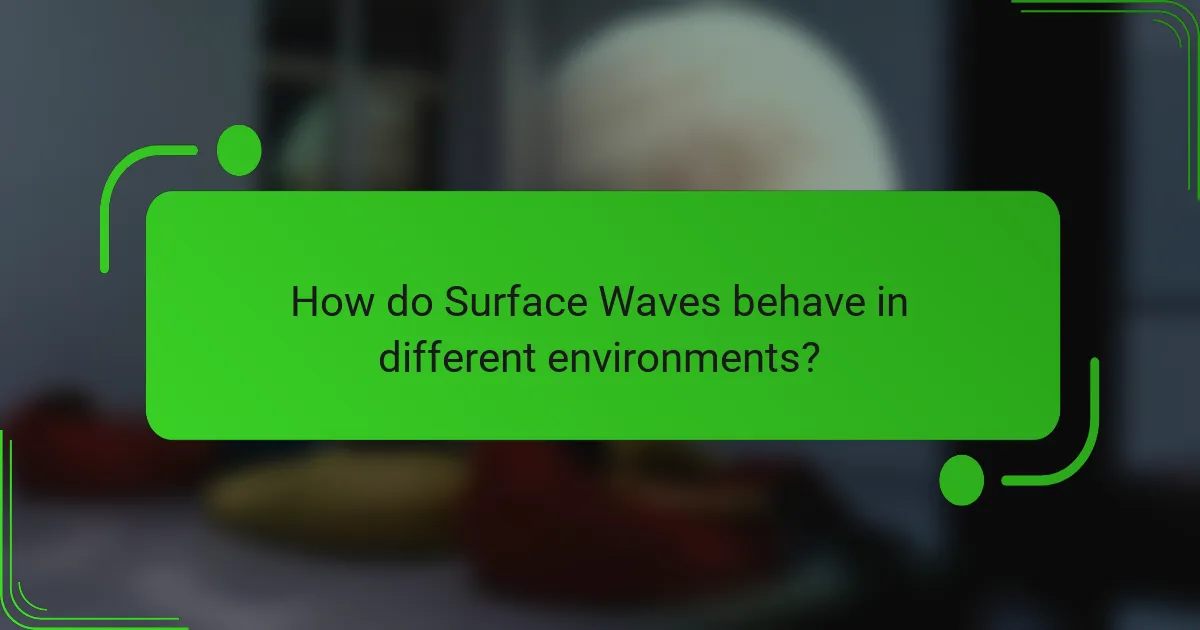
How do Surface Waves behave in different environments?
Surface waves behave differently in various environments due to factors like medium properties and boundary conditions. In elastic media, surface waves travel along the surface, exhibiting characteristics such as dispersion. Their speed and amplitude can vary depending on material density and elasticity. In water, surface waves are influenced by wind speed and depth, leading to changes in wave height and energy. In solid materials, surface waves can cause significant damage during seismic events. The interaction with obstacles or changes in medium can also alter their path and intensity. For instance, surface waves may reflect or refract when encountering different materials, affecting their overall behavior.
What factors influence the propagation of Surface Waves?
Surface waves are influenced by several key factors. These factors include the medium through which they travel, such as soil or water. The properties of the medium, like density and elasticity, affect wave speed and amplitude. Surface waves also depend on frequency; higher frequencies can lead to shorter wavelengths. Additionally, environmental conditions, such as temperature and moisture, can alter propagation. The presence of obstacles, like buildings or geological features, can reflect or refract waves. Lastly, the initial energy input, including the source and magnitude of the disturbance, plays a crucial role. These factors collectively dictate how surface waves behave in various contexts.
How does soil composition affect Surface Wave speed?
Soil composition significantly affects surface wave speed. Different soil types have varying densities and elastic properties. For example, cohesive soils like clay tend to have lower wave speeds due to their higher water content and plasticity. In contrast, granular soils such as sand exhibit higher wave speeds due to their compactness and lower moisture levels. The presence of organic matter also influences wave propagation, as it can decrease density and increase damping. Studies have shown that wave speed can vary by as much as 50% depending on soil composition. This variation is critical for engineering applications, as it impacts the design and stability of structures built on or within the ground.
What is the impact of moisture content on Surface Wave behavior?
Moisture content significantly impacts surface wave behavior. High moisture levels generally increase wave velocity in saturated soils. This occurs because water fills the voids between soil particles, enhancing particle interaction. Conversely, low moisture content can lead to reduced wave velocity. Dry conditions create more air gaps, decreasing particle cohesion. Research indicates that changes in moisture can alter the soil’s elastic modulus, affecting wave propagation. For instance, studies show that saturated soils exhibit higher shear wave velocities compared to unsaturated soils. This relationship is crucial for understanding soil behavior in engineering applications.
How do Surface Waves interact with structures?
Surface waves interact with structures primarily through oscillation and displacement. These waves can cause vibrations within the material of the structure. The interaction leads to stress concentration at points of support or discontinuity. This can result in structural damage if the intensity of the waves is high. Research shows that surface waves can amplify ground motion during seismic events. For instance, buildings on soft soil are more susceptible to damage from surface waves. Additionally, the frequency of surface waves can resonate with the natural frequency of structures, increasing the risk of failure.
What types of structures are most affected by Surface Waves?
Surface waves primarily affect structures such as buildings, bridges, and dams. These structures are often designed to withstand vertical and horizontal forces. However, surface waves can induce significant ground motion. This motion may lead to structural damage or failure, particularly in taller buildings. For example, the 1994 Northridge earthquake showed that surface waves caused extensive damage to various structures. Additionally, bridges can experience lateral displacements due to surface waves. This can compromise their integrity and safety. Overall, structures that are rigid and tall are most vulnerable to the impacts of surface waves.
How do Surface Waves cause damage to buildings and infrastructure?
Surface waves cause damage to buildings and infrastructure primarily through ground shaking and displacement. These waves travel along the Earth’s surface, creating strong horizontal and vertical motions. This shaking can lead to structural failure in buildings, especially those not designed to withstand seismic forces.
The most vulnerable structures are those with weak foundations or poor construction materials. For instance, in the 1994 Northridge earthquake, surface waves contributed significantly to the damage, resulting in billions of dollars in repair costs.
Additionally, surface waves can cause soil liquefaction, where saturated soil loses strength and behaves like a liquid. This phenomenon can lead to severe settling or tilting of structures.
In summary, surface waves generate intense shaking and can induce soil instability, both of which pose significant risks to buildings and infrastructure.
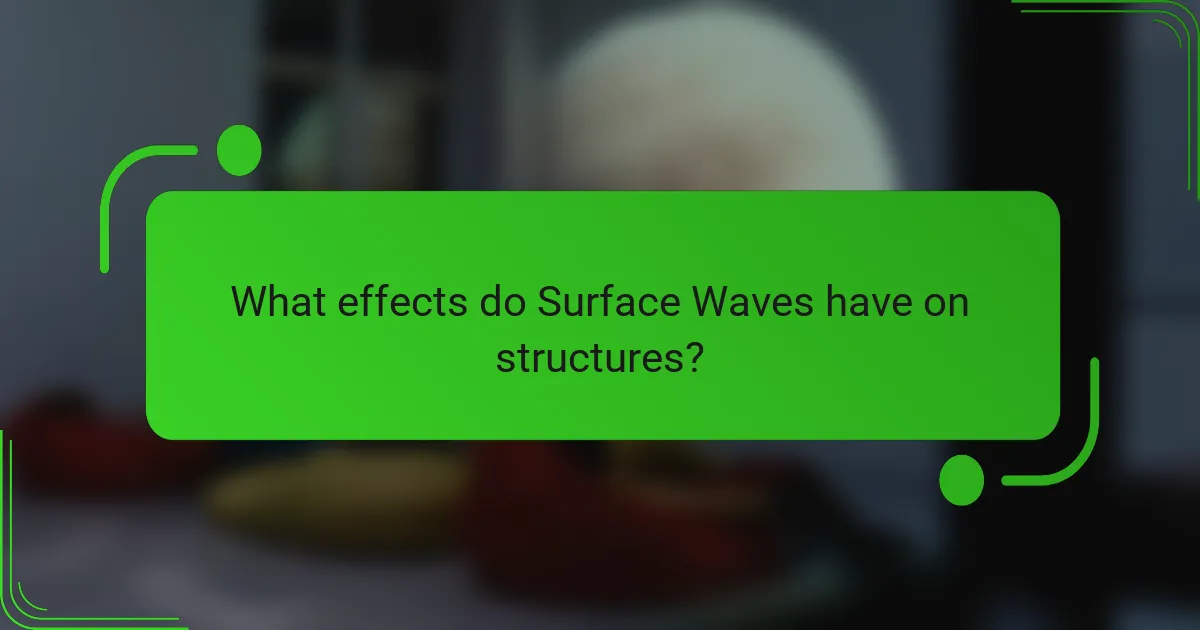
What effects do Surface Waves have on structures?
Surface waves can cause significant effects on structures. They induce ground motion that can lead to vibrations in buildings and bridges. These vibrations may result in structural damage, especially in tall or flexible structures. Surface waves often have longer wavelengths, which can amplify their impact on foundations. The shaking can also affect the stability of soil, potentially leading to liquefaction in saturated conditions. Historical data from earthquakes shows that structures near the epicenter are particularly vulnerable to surface wave effects. For example, the 1994 Northridge earthquake demonstrated extensive damage due to surface wave propagation.
How can Surface Waves be measured and analyzed?
Surface waves can be measured and analyzed using various techniques. Common methods include seismic sensors and accelerometers. These devices capture the wave’s amplitude and frequency. Data from these sensors are processed using signal analysis software. Advanced techniques like time-frequency analysis enhance understanding of wave behavior. Additionally, numerical modeling can simulate surface wave propagation. Field experiments validate these models by comparing theoretical and observed data. Researchers often utilize these methods to assess the impact of surface waves on structures.
What instruments are used to detect Surface Waves?
Seismometers are the primary instruments used to detect surface waves. These devices measure ground motion caused by seismic waves. Accelerometers are also utilized to capture rapid changes in motion. Geophones convert ground movement into electrical signals for analysis. In addition, laser vibrometers can measure surface vibrations without contact. Each instrument provides valuable data for understanding surface wave behavior. Research has shown that these tools are essential for seismic studies. For example, the USGS employs seismometers to monitor earthquakes and their effects.
How is data from Surface Wave analysis interpreted?
Data from Surface Wave analysis is interpreted by analyzing the dispersion characteristics of surface waves. These characteristics provide insights into the subsurface material properties. Analysts typically use phase velocity and frequency data to determine shear wave velocity profiles. The interpretation often involves comparing observed data with theoretical models. Inversion techniques are applied to estimate the subsurface structure. These techniques can yield information on layer thickness and material stiffness. The accuracy of interpretations is validated through field tests and comparisons with borehole data. This method is widely used in geotechnical engineering and seismic studies.
What are the implications of Surface Wave analysis for engineering?
Surface Wave analysis has significant implications for engineering, particularly in geotechnical and structural assessments. It aids in evaluating the mechanical properties of soil and rock layers. Accurate assessment of these properties is crucial for foundation design and stability analysis.
Surface Wave analysis provides insights into shear wave velocity, which is essential for seismic risk evaluation. This method allows engineers to determine site response during earthquakes. It also facilitates the identification of subsurface anomalies, which can impact construction safety.
Furthermore, Surface Wave analysis contributes to the optimization of engineering designs by reducing uncertainty in material properties. The use of non-invasive techniques minimizes disturbance to the site, preserving the integrity of existing structures.
Overall, Surface Wave analysis enhances the reliability of engineering projects by providing critical data for informed decision-making.
How can engineers design structures to withstand Surface Waves?
Engineers can design structures to withstand surface waves by employing specific structural materials and techniques. They often use reinforced concrete and steel frameworks for enhanced durability. Additionally, engineers incorporate flexible designs that allow for movement during wave impacts. This flexibility helps to dissipate energy and minimize damage.
The use of deep foundations can also improve stability against wave forces. Engineers may implement breakwaters or sea walls to reduce wave energy before it reaches structures. Advanced modeling techniques, such as computational fluid dynamics, help predict wave behavior and inform design choices.
Research indicates that structures designed with these methods can significantly reduce the risk of failure during extreme wave events. For instance, studies have shown that buildings with proper wave-resistant designs can withstand forces exceeding 50% greater than conventional structures.
What best practices should be followed in Surface Wave assessment?
Best practices in Surface Wave assessment include proper site selection, accurate equipment calibration, and thorough data analysis. Site selection should consider geological conditions and potential interference from nearby structures. Equipment calibration ensures accurate measurements of wave velocities. Data analysis should employ robust inversion techniques to interpret the surface wave data effectively. Consistent methodology in data collection enhances reliability. Additionally, conducting multiple tests can confirm results and account for variability. Following these practices leads to more reliable assessments of subsurface conditions.
What are the common challenges in analyzing Surface Waves?
Common challenges in analyzing surface waves include signal interference, data interpretation difficulties, and environmental factors. Signal interference arises from noise and overlapping waves, complicating clear analysis. Data interpretation is challenging due to the complex behavior of surface waves. Environmental factors, such as soil composition and moisture content, affect wave propagation and can lead to inaccurate results. Additionally, limited access to measurement sites can hinder data collection. These challenges necessitate advanced analytical techniques and careful consideration of external influences.
How can inaccuracies in measurement affect analysis?
Inaccuracies in measurement can significantly distort analysis outcomes. They lead to erroneous conclusions about surface wave behavior. For instance, slight errors in measuring wave amplitude can result in incorrect assessments of structural impact. Accurate measurements are critical for predicting how structures respond to surface waves. Research indicates that a 5% measurement error can lead to up to 20% variation in analysis results. This highlights the importance of precision in data collection. Without reliable measurements, the integrity of the entire analysis is compromised. Consequently, decision-making based on flawed data can result in unsafe structural designs.
What strategies can be employed to improve Surface Wave analysis?
To improve Surface Wave analysis, utilize advanced algorithms for data processing. Implementing machine learning techniques enhances pattern recognition in waveforms. Additionally, increasing the density of measurement points provides more accurate data. Utilizing multi-channel recording systems captures detailed wave propagation characteristics. Incorporating numerical modeling simulates various subsurface conditions effectively. Regular calibration of equipment ensures measurement accuracy over time. Adopting standardized protocols facilitates consistent data interpretation across studies. These strategies collectively enhance the reliability and accuracy of Surface Wave analysis.
Surface waves are a type of seismic wave that travel along the Earth’s surface, primarily causing ground shaking during earthquakes. This article analyzes the attributes, behavior, and effects of surface waves on structures, highlighting their unique characteristics, such as elliptical motion and varying amplitudes based on frequency and soil composition. It discusses the significant impact of surface waves on engineering, including how they interact with structures and the best practices for assessment and design. Additionally, the article addresses the challenges in analyzing surface waves and strategies to improve measurement accuracy and data interpretation.
